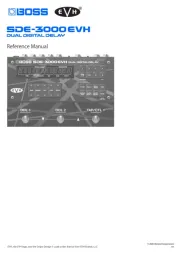Boss Reverb RV-500 Handleiding
Boss
Niet gecategoriseerd
Reverb RV-500
Bekijk gratis de handleiding van Boss Reverb RV-500 (28 pagina’s), behorend tot de categorie Niet gecategoriseerd. Deze gids werd als nuttig beoordeeld door 43 mensen en kreeg gemiddeld 4.5 sterren uit 22 reviews. Heb je een vraag over Boss Reverb RV-500 of wil je andere gebruikers van dit product iets vragen? Stel een vraag
Pagina 1/28

Getting Ready . . . . . . . . . . . . . . . . . . . . . . . . . . . 2
Installing the Batteries . . . . . . . . . . . . . . . . . . 2
Connecting the Equipment. . . . . . . . . . . . . . . 2
Basic Operation . . . . . . . . . . . . . . . . . . . . . . . . . 4
Adjusting the Reverb . . . . . . . . . . . . . . . . . . . 4
Adjusting the Delay . . . . . . . . . . . . . . . 5
Turning Reverb On/O . . . . . . . . . . . . . . . . . . 6
Switching Banks/Patches . . . . . . . . . . . . . . . . 7
Using the [TAP/CTL] Switch to Control the
Reverb . . . . . . . . . . . . . . . . . . . . . . . . . . . . . 8
Editing a Patch . . . . . . . . . . . . . . . . . . . . . . . . . . 9
Saving a Patch . . . . . . . . . . . . . . . . . . . . . . . . . . 10
Parameter List . . . . . . . . . . . . . . . . . . . . . . . . . . 11
PATCH . . . . . . . . . . . . . . . . . . . . . . . . . . . . . . 11
Parameters Common to All Modes . . . . 11
Parameters for Each Mode . . . . . . . . . . 12
CONTROL . . . . . . . . . . . . . . . . . . . . . . . . . . . 16
ASSIGN . . . . . . . . . . . . . . . . . . . . . . . . . . . . . 16
BANK . . . . . . . . . . . . . . . . . . . . . . . . . . . . . . 18
SYSTEM . . . . . . . . . . . . . . . . . . . . . . . . . . . . . 18
MIDI . . . . . . . . . . . . . . . . . . . . . . . . . . . . . . . 18
MIDI PC MAP . . . . . . . . . . . . . . . . . . . . . . . . . 19
Convenient Functions . . . . . . . . . . . . . . . . . . . . 20
Specifying Whether to Carry-Over the Reverb
Sound . . . . . . . . . . . . . . . . . . . . . . . . . . . . . . 20
Assigning the Functions of the [A], [B], and
[TAP/CTL] Switches . . . . . . . . . . . . . . . . . . . . 20
Using Two Patches Simultaneously
(Simul Mode) . . . . . . . . . . . . . . . . . . . 21
Assigning a Function to an External Pedal. . . . . 22
Synchronizing with a DAW or External MIDI
Device . . . . . . . . . . . . . . . . . . . . . . . . . . . . . . . . . 24
Connection Example . . . . . . . . . . . . . . . . . . . 24
MIDI Messages That Can Be Transmitted and
Received . . . . . . . . . . . . . . . . . . . . . . . . . . . . 24
MIDI Routing . . . . . . . . . . . . . . . . . . . . . . . . . 25
Restoring the Factory Default Settings . . . . . . . 26
Transmitting Data to an External MIDI Device . . 26
Troubleshooting . . . . . . . . . . . . . . . . . . . . . . . . . 27
Main Specications . . . . . . . . . . . . . . . . . . . . . . 27
USING THE UNIT SAFELY . . . . . . . . . . . . . . . . . . . 28
IMPORTANT NOTES . . . . . . . . . . . . . . . . . . . . . . 28
Before using this unit, carefully read “USING THE UNIT SAFELY” and “IMPORTANT NOTES” (leaet “USING THE UNIT SAFELY” and Owner’s Manual
(p. 28)). After reading, keep the document(s) including those sections where it will be available for immediate reference.
5Thanks to 32-bit high-precision processing at a 96 kHz sampling rate from input to output, the
RV-500 gives you stunningly high-quality reverb.
5With an easily readable screen and an independent [TAP/CTL] switch, it delivers both high
functionality as well as ease of use during live performances.
5A total of 12 types of reverb are provided, including classic varieties as well as “DUAL” which lets
you use two reverbs simultaneously, the sparkling “SHIMMER,” and models such as “Roland SPACE
ECHO RE-201” and “Roland DIGITAL REVERB SRV-2000.” Powerful DSP lets you use delay and
modulation simultaneously for all reverbs.
5The memory function lets you store and recall 297 dierent setups from internal memory.
“CARRYOVER” provides seamless transition that preserves the reverberant sound when switching
between patches.
5By connecting the RV-500 via a USB cable or MIDI cables, you can switch sounds and control
parameters in synchronization with your computer DAW or an external MIDI device.
© 2017 Roland Corporation
Owner’s Manual

2
Getting Ready
Installing the Batteries
Install four alkaline batteries (AA, LR6) in the battery compartment located on the bottom of the
unit.
* When turning the unit over, be careful so as to protect the buttons and knobs from damage.
Also, handle the unit carefully; do not drop it.
* If you handle batteries improperly, you risk explosion and uid leakage. Make sure that you
carefully observe all of the items related to batteries that are listed in “USING THE UNIT SAFELY”
and “IMPORTANT NOTES” (separate sheet “USING THE UNIT SAFELY” and Owner’s manual (p. 28)).
* We recommend that you keep batteries installed in the unit even though you’ll be powering it
with the AC adaptor. That way, you’ll be able to continue a performance even if the cord of the
AC adaptor gets accidently disconnected from the unit.
* “BATTERY LOW” will appear on the display if the batteries are low. Replace them with new ones.
Attaching the Rubber Feet
You can attach the rubber feet (included) if necessary.
Attach them in the locations shown in the illustration.
Connecting the Equipment
* To prevent malfunction and equipment failure, always turn down the volume, and turn o all
the units before making any connections.
DC IN jack
Accepts connection of an AC Adaptor (PSA-S series; sold
separately). By using an AC Adaptor, you can play without
being concerned about how much battery power you have left.
* Use only the specied AC adaptor (PSA-S series; sold
separately), and connect it to an AC outlet of the correct
voltage. Do not use any other AC adaptor, since this may
cause malfunction.
* If the AC adaptor is connected while power is on, the power
supply is drawn from the AC adaptor.
USB (O) port
Use a commercially available
USB 2.0 cable to connect this
port to your computer.
You can synchronize with a
DAW via MIDI.
MIDI IN, OUT connectors
Connect an external MIDI
device here.
You can synchronize with
an external MIDI device
via MIDI.
MIDI device

3
Getting Ready
CTL 1, 2/EXP jack
You can control various parameters by connecting a footswitch (FS-5U, FS-5L, FS-6, FS-7: sold separately) or an expression pedal (such as
the EV-30, Roland EV-5: sold separately) to the CTL 1, 2/EXP jack (p. 22).
When connecting expression
pedal
EXP
* Use only the specied
expression pedal (EV-30,
Roland EV-5; sold separately).
By connecting any other
expression pedals, you risk
causing malfunction and/or
damage to the unit.
When Connecting an FS-7When Connecting an FS-6
MODE/POLARITY switch
CTL 2 CTL 1
Stereo 1/4” phone type
,Stereo 1/4” phone type
MODE/POLARITY switch
When Connecting an FS-5U
(or FS-5L)
When Connecting Two FS-5Us
(or FS-5Ls)
1/4” phone type ,1/4”
phone type
CTL 1 CTL 2 CTL 1
POLARITY switch
Stereo 1/4” phone type
,1/4” phone type x 2
When connecting an FS-5L, set MODE to
“MOMENT” (p. 22).
OUTPUT A/MONO, B jacks
Connect these jacks to your amp
or monitor speakers.
If you’re using a mono setup, use
only the OUTPUT A/MONO jack.
* Do not connect headphones to
the OUTPUT A/MONO, B jacks.
Doing so may damage the
headphones.
INPUT A/MONO, B jacks
Connect your electric guitar, or another instrument or eect unit, to these jacks.
* Use the INPUT A/MONO jack and B jack when connecting a stereo-output eects unit. Use
only the INPUT A/MONO jack if you’re using a mono source.
Turning the power on/o
The INPUT A/MONO jack doubles as the power switch. Power to the unit is turned on when
you plug into the INPUT A/MONO jack; the power is turned o when the cable is unplugged.
When powering up:
Turn on the power to your amp last.
When powering down:
Turn o the power to your amp
rst.
Stereo 1/4” phone type
,Stereo 1/4” phone type
Product specificaties
| Merk: | Boss |
| Categorie: | Niet gecategoriseerd |
| Model: | Reverb RV-500 |
Heb je hulp nodig?
Als je hulp nodig hebt met Boss Reverb RV-500 stel dan hieronder een vraag en andere gebruikers zullen je antwoorden
Handleiding Niet gecategoriseerd Boss

2 April 2025

25 Februari 2025

27 Januari 2025

30 November 2024

30 November 2024

30 November 2024

30 November 2024

30 November 2024

30 November 2024

30 November 2024
Handleiding Niet gecategoriseerd
- Walrus Audio
- Speaka
- Exagerate
- Tessan
- Steelbody
- Freedor
- Ingenico
- Minix
- Optex
- Doktorvolt
- Kenton
- Benchmark USA
- ESKA
- Colt
- Jata
Nieuwste handleidingen voor Niet gecategoriseerd

14 September 2025

14 September 2025

13 September 2025

13 September 2025

13 September 2025

13 September 2025

13 September 2025

13 September 2025

13 September 2025

13 September 2025